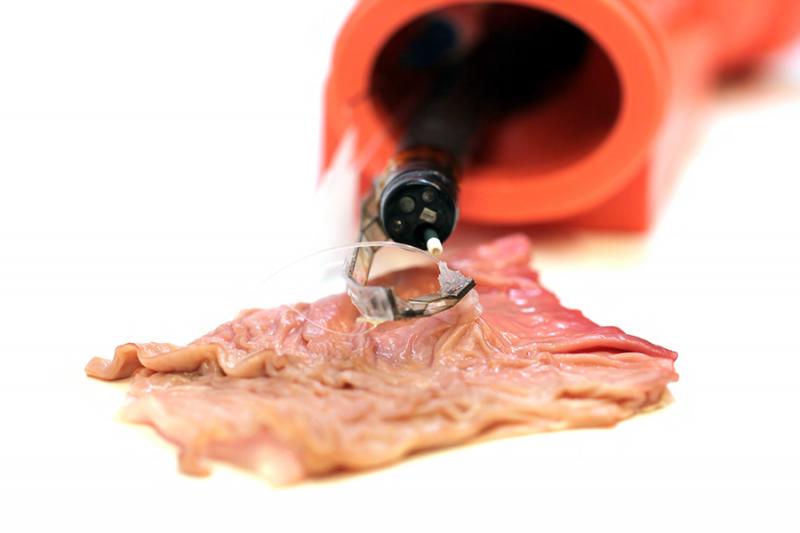In Insert Coin, we look at an exciting new tech project that requires funding before it can hit production. If you'd like to pitch a project, please send us a tip with "Insert Coin" as the subject line.

Cardboard Robot has lowered it's crane claw boom on all the Kickstarter money business, and said "Hey, let's have a little fun here, too." It's a robotic arm kit consisting of four stepper motors, a controller, USB computer connection, and a structure made from corrugated cardboard with a claw or smartphone camera mount. While able to pick up small objects like socks and stuffed animals or crane a smartphone around, the fanciful bot's main function seems to be the fun of piecing it together, with its pliable surface also safer for working with kids. To that end, the mech's maker said that not only would it be easy to build, but the source code would be included for tweaking and with every $3k raised, one of the kits would be donated to a US school. So, if you want your own carton-y bot arm kit for learning and light plush toy duty (assembly required), the minimum pledge is $175 -- check the Kickstarter source to see how to pony up, or the video after the break.
Continue reading Insert Coin: Cardboard Robot brings craning, plucking and learning with a dash of whimsey (video)
Filed under: Robots
Insert Coin: Cardboard Robot brings craning, plucking and learning with a dash of whimsey (video) originally appeared on Engadget on Wed, 11 Jul 2012 19:51:00 EDT. Please see our terms for use of feeds.
Permalink |
 Kickstarter
Kickstarter |
Email this |
Comments
 NASA's spacecraft OSIRIS-REx is just 75 miles from its destination and, just like you would near the end of a light, it's starting to stretch out. The craft successfully tested its Touch-and-Go Sample Acquisition Mechanism (TAGSAM), a robotic arm tha...
NASA's spacecraft OSIRIS-REx is just 75 miles from its destination and, just like you would near the end of a light, it's starting to stretch out. The craft successfully tested its Touch-and-Go Sample Acquisition Mechanism (TAGSAM), a robotic arm tha...
 NASA's spacecraft OSIRIS-REx is just 75 miles from its destination and, just like you would near the end of a light, it's starting to stretch out. The craft successfully tested its Touch-and-Go Sample Acquisition Mechanism (TAGSAM), a robotic arm tha...
NASA's spacecraft OSIRIS-REx is just 75 miles from its destination and, just like you would near the end of a light, it's starting to stretch out. The craft successfully tested its Touch-and-Go Sample Acquisition Mechanism (TAGSAM), a robotic arm tha...
 Volkswagen's I.D. platform just got its flagship product, the Vizzion. The electric vehicle will have a range of about 370 miles (600 kilometers) via a 111kWh battery pack, two motors for all-wheel-drive capabilities and will be ready for autonomous...
Volkswagen's I.D. platform just got its flagship product, the Vizzion. The electric vehicle will have a range of about 370 miles (600 kilometers) via a 111kWh battery pack, two motors for all-wheel-drive capabilities and will be ready for autonomous...
 Minimally invasive surgery is already amazing as it is, but a team of Harvard scientists have created a device that expands its possible applications even further. They designed a tiny robotic arm that lays flat while the endoscope is moving through...
Minimally invasive surgery is already amazing as it is, but a team of Harvard scientists have created a device that expands its possible applications even further. They designed a tiny robotic arm that lays flat while the endoscope is moving through...
 Today on In Case You Missed It: Artist Sougwen Chung creates art with help from a robotic arm, take a tour of 3M's exhibit, which visualizes the challenges the earth will face by 2050 and finally, bask in the glow of a large orb with AI that change...
Today on In Case You Missed It: Artist Sougwen Chung creates art with help from a robotic arm, take a tour of 3M's exhibit, which visualizes the challenges the earth will face by 2050 and finally, bask in the glow of a large orb with AI that change...
 Roland Behrens, a German scientist, wants to teach robots how not to kill humans. But first, he needs to know how hard they can hit before causing any serious damage. According to a Bloomberg report, a team of researchers at the Fraunhofer IFF Inst...
Roland Behrens, a German scientist, wants to teach robots how not to kill humans. But first, he needs to know how hard they can hit before causing any serious damage. According to a Bloomberg report, a team of researchers at the Fraunhofer IFF Inst...
 You might not be able to control the 7Bot robotic arm with your mind or your eyes, but at least it'll only cost you around $350 -- cheaper than an iPhone, its creators point out -- to get one. Even better, you don't need to know how to code to prog...
You might not be able to control the 7Bot robotic arm with your mind or your eyes, but at least it'll only cost you around $350 -- cheaper than an iPhone, its creators point out -- to get one. Even better, you don't need to know how to code to prog...










